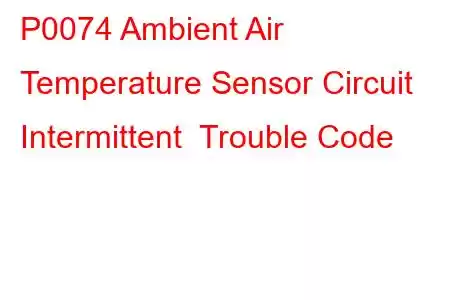P0074 Ambient Air Temperature Sensor Circuit Intermittent
OBD-II Trouble Code Technical Description
Ambient Air Temperature Sensor Circuit Intermittent
What does that mean?
This generic powertrain/engine diagnostic trouble code typically applies to all OBDII equipped vehicles.
The Ambient Air Temperature (AAT) sensor converts ambient air temperature into an electrical signal for the Powertrain Control Module (PCM). This input is used to modify air conditioning system operation and display outside air temperature.
The PCM receives this input and possibly two more; Intake Air Temperature (IAT) and Engine Coolant Temperature Sensor (ECT). The PCM looks at the AAT sensor voltage and compares it to the IAT/ECT sensor readings when the ignition switch is first turned on after a long cool down period. This code is set if these inputs vary too much. It also looks at the voltage signals from these sensors to determine if they are correct when the engine is fully warmed up. This code is usually set due to electrical issues.
Troubleshooting steps may vary depending upon manufacturer, type of AAT sensor and wire colors.
Symptoms
Symptoms may include:
Malfunction Indicator Light On Air Conditioning may not perform properly Instrument cluster may not read outside temperature accurately Overhead console may not read outside temperature accuratelyCauses
Potential causes of a P0074 trouble code may include:
Intermittent open in the signal circuit to the AAT sensor - likely Intermittent short to voltage in the signal circuit to the AAT sensor Intermittent short to ground in the signal circuit to the AAT sensor Faulty AAT sensor Failed PCM - unlikelyPossible Solutions
A good starting point is always to check for technical service bulletins (TSB) for your particular vehicle. Your issue may be a known issue with a known fix put out by the manufacturer and can save you time and money during diagnosis.
Next, locate the AAT sensor on your particular vehicle. This sensor is usually found in front of the radiator behind the grille or front bumper area. Once located, visually inspect the connectors and wiring. Look for scraping, rubbing, bare wires, burn spots or melted plastic. Pull the connectors apart and carefully inspect the terminals (the metal parts) inside the connectors. See if they look burned or have a green tint indicating corrosion. Use electrical contact cleaner and a plastic bristle brush if cleaning of the terminals is needed. Let dry and apply electrical grease where the terminals contact.
The most common failure is connections, with a failed sensor a close second due to its adverse environment.
While checking the connections you can test the sensor with a Digital Volt-Ohm Meter (DVOM). With the ignition switch off, disconnect the sensor and connect the Red (Positive) lead of the DVOM to one post on the sensor and the Black (Negative) lead of the DVOM to the other post. Determine the temperature of the sensor (what is the temperature outside) to the resistance on the chart. This is the resistance in ohms that your DVOM should be displaying. Either 0 ohms or infinite resistance (usually indicated by the letters OL) indicates a failed sensor.
If you have a scan tool, clear the diagnostic trouble codes from memory, and see if this code returns. If it does not, then the connections were most likely your problem.
If the P0070 code does return, we will need to test the AAT sensor and its associated circuits. Typically, there are 2 wires at the AAT sensor. With the ignition switch off, disconnect the harness going to the AAT sensor. Turn the ignition switch on. With a scan tool accessing PCM data (provided that is the module receiving the AAT sensor input; the module receiving the AAT sensor input may be the Air Conditioning control module, Generic Electronic Module or some other
Read: 50


